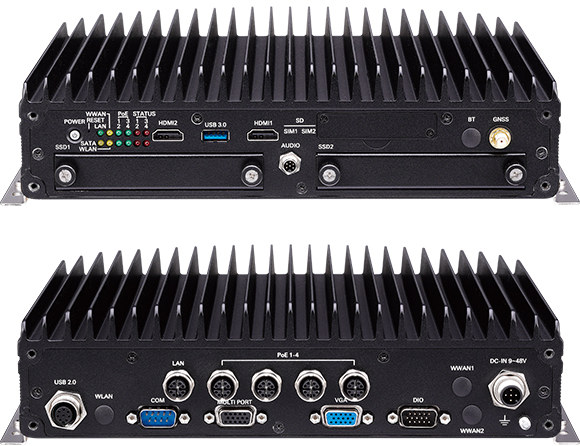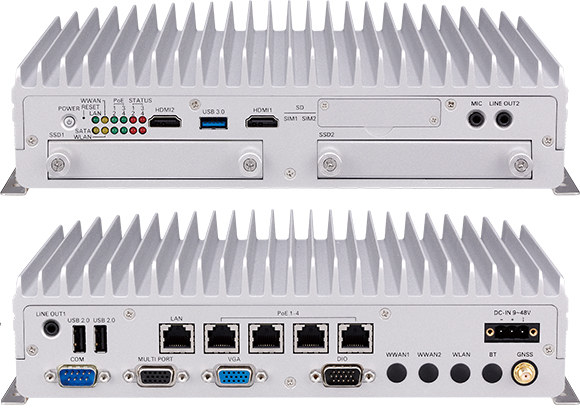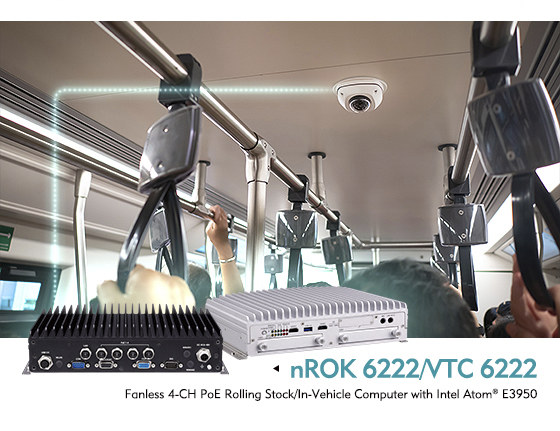Taiwan based NEXCOM has introduced two new mobile computing solutions specifically designed for transportation with nROK 6222/VTC 6222 Intel Apollo Lake computers enabling 24/7 monitoring of trains, buses, trucks, and other vehicles.
The computers come with five Ethernet ports, including four PoE enable, in order to connect IP cameras, and two HDMI output, one VGA output to let drivers monitor the front and back of the vehicle, and passengers view travel-related or other information.

NEXCOM nROK 6222/VTC 6222 key features and specifications:
- SoC – Intel Atom x7-E3950 quad-core Apollo Lake processor clocked at 1.6 GHz / 2.0GHz with Intel HD Graphics 505
- System Memory – 4GB DDR3L 1866 SO-DIMM (default) up to 8GB
- Storage – 2x 2.5″ SATA 3.0 SSD up to 15mm thick, SD card slot, internal USB DOM
- Video Output – VGA, 2 x HDMI
- Connectivity
- nROK 6222 – 1x Gigabit Ethernet (M12) port, 4x Ethernet (M12) ports with 802.3af/at PoE (60W max)
- VTC 6222 – 1x Gigabit Ethernet (RJ45) port, 4x Ethernet (RJ45) ports with 802.3af/at PoE (60W max)
- WiFi (no details provided)
- Cellular via M.2/mPcie + 2x eSIM (optional)
- GNSS – GPS, Galileo, GLONASS, BeiDou via u-blox NEO-M8N module
- Expansion
- 2x mini PCIe socket with PCIe 2.0 + USB 2.0
- 1x mini PCIe socket with USB 2.0
- Optional M.2 key B socket with USB 2.0 & USB 3.0
- DIO connector
- Power Input
- nROK 6222 – DC 24/36V (w/o isolation) , optional DC 24/110V (w/ isolation, external power kit)
- VTC 6222 – DC 9V to 48V
- Certifications
- nROK 6222 – CE, FCC Class A,EN50155 (railway certification)
- VTC 6222 – CE, FCC Class A, E13
- Dimensions – 260 x 196 x 66.5mm
- Weight – nROK: 3.4kg; VTC: 3.2 kg
- Temperature Range – -40°C to 70°C

Both models are pretty similar, and the most obvious differences are the round M12 Ethernet/USB connectors and M8 audio connector used on nROK 6222 that specifically targets railway transportation, while VTC 6222 should be better suited to buses or trucks.
Both in-vehicle computers can be waked on by ignition, and some other features not listed in the specs above include 12x LEDs, optional TPM 2.0 security, power and reset buttons, selectable boot-up and shut-down voltage, 8-level power on/off delay, S3/S4 suspend mode, a watchdog, and an RTC.
The computers can run either Windows 10 or Linux, and can assists with centralized fleet management via the cloud, GPS, and Wi-Fi, so fleet owners can monitor drivers’ behaviors, and document any accidents or thefts occurring in their vehicles.

Via LinuxGizmos

Jean-Luc started CNX Software in 2010 as a part-time endeavor, before quitting his job as a software engineering manager, and starting to write daily news, and reviews full time later in 2011.
Support CNX Software! Donate via cryptocurrencies, become a Patron on Patreon, or purchase goods on Amazon or Aliexpress




